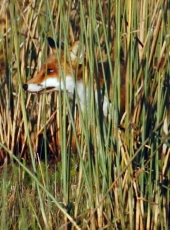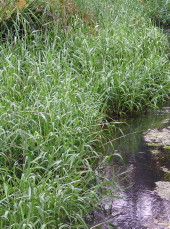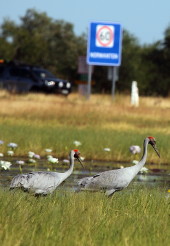Brolga FAQ 4
This page covers Brolga conservation. Size, calls, locations and numbers are in FAQ 1. Food and water are in FAQ food and water while breeding habitat, nests, eggs and chicks are in FAQ 2. FAQ 3 covers behaviour and dry season habitats. Background to Brolgas and Sarus Cranes with comparison photos is on Ozcranes Australia/New Guinea Cranes Intro page.
For interactions between Brolgas and Sarus Cranes in northern Australia, including potential hybrids, see Sarus Crane FAQ 3».
Status and protection
All jurisdictions protect wildlife through legislation and treaties, which is a different process from assessing threat levels in each place. New Guinea (PNG and Irian Jaya, Indonesia) would be better listed as Data Deficient, current numbers and threats are unknown.
Details of Brolga conservation status
| Level | Status |
|---|---|
| International | Least Concern |
| Australia | Least Concern |
| New Guinea (PNG & Irian Jaya) | Least Concern |
| New South Wales | Vulnerable |
| Northern Territory | Least Concern |
| Queensland | Least Concern |
| South Australia | Vulnerable |
| Victoria | Vulnerable |
| Western Australia | Least Concern |
CommentIn Australia, threat levels of Vulnerable and above are managed through an integrated State/Commonwealth process, while allocating ‘Near Threatened’ status (below Vulnerable) is managed at State level. Almost all Brolgas in Australia (at least 50,000) occupy the ‘Top End’ and far north coasts of Western Australia, Queensland and the Northern Territory. All three classify Brolga as Least Concern, and with the large numbers of northern Brolgas this is unlikely to change.
Conservation actions The three states with Vulnerable Brolga populations have a range of conservation programs, with Commonwealth and community support (see under Wetlands, below). BirdLife has declared seven Key Biodiversity Areas with Brolga as a trigger species: see Ozcranes Conservation Key Biodiversity Areas». Ozcranes Crane-friendly Fencing» guidelines were developed in consultation with north Queensland catchment groups in the 2005-2010 NRM plan process. Though not related to conservation protection, the Brolga is recognised as the state bird emblem of Queensland.
The Brolga review from the global Crane Conservation Strategy» can be downloaded from ResearchGate (pdf 4.8MB, free).
Risks and Threats

In southern Australia a combination of many factors is known to have caused a serious decline in Brolga population. Major drainage works, diversions to deep water storages and overgrown roost sites have caused Brolgas to desert sites or districts.
← Pig eating lilies in Swamp, Gulf Plains, NW Qld (P Merritt)
All the following risks are also known or suspected to impact Brolgas in the south or north, but there are no systematic records or studies:
- It's reported many Brolgas were killed in the past by hunting and culling due to agricultural damage [1]; for discussion of persecution and a recent case from north Queensland see Ozcranes Crane Hazards 2»
- Powerlines have caused deaths in Victoria [2] and in far north Queensland (Elinor Scambler, John Grant)
- In southern Australia feral foxes are assumed to be a significant threat to breeding success
- Brolga habitats in northern Australia have major weed issues
- Wild pigs: Smaller water sources can be seriously damaged and there is debate over whether fiercely aggressive Brolga males can defend nests against pigs. But interestingly some observers have noted Bulkuru sedge (Elaeocharis spp), a key Brolga wetland food, spreads after pig disturbance in swamps [3]
- Breeding southern Brolgas may be isolated from the northern Brolga population, possibly creating risk from genetic bottlenecks. A magazine article and preliminary scientific report on the Brolga Genetics Project can be read at Nature Glenelg Trust».
[1] DM White (1987). The status and distribution of the Brolga in Victoria, Australia. Proceedings of the 1983 International Crane Workshop, ICF.
[2] PW Goldstraw & PB Du Guesclin (1991). Bird casualties from collisions with a 500KV transmission line in southwestern Victoria, Australia. Proceedings of the 1987 International Crane Workshop, ICF.
[3] S Garnett & R Bredl (1985). Birds in the vicinity of the Edward River Settlement, Part 1. Sunbird 15, pp 6-23. Birds Queensland.
Wetlands and Brolga conservation
As detailed in Brolga FAQs 2 and FAQs 3 wetlands are the most critical habitat for cranes, including Brolgas. Major wetland restoration projects are underway for threatened southern Brolgas, and other wetland-dependent species in SW Victoria and SE South Australia.
↓ Brolga at restored wetland Winter Swamp (Mullahwallah Wetlands) near Ballarat, Victoria (Ed Dunens)


↑ Pick Swamp, SE South Australia, a major wetland restoration project (Matt Herring)
Inka Veltheim's research on the home range and movements of pre-fledged Brolga chicks found they mostly moved within 2km of 1-3 separate wetlands, so future habitat management for southern Brolga breeding should incorporate 3 wetlands and movement corridors. Brolgas cannot nest or spend the flocking season on wetlands or other habitats choked with thick vegetation, as has happened on the Townsville Town Common (see Ozcranes Conservation Burning for Brolgas: Restoring wetlands with grazing and fire»).
↓ Townsville Town Common, once a significant Brolga flocking site until overtaken by introduced Para Grass (denisbin)

Projects and resources
- Victoria
- Glenelg-Hopkins Catchment Management Authority have many wetland resources
- Nature Glenelg Trust current projects
- Mt Burr Swamp Restoration Project, Nature Glenelg Trust
- Hamilton Field Naturalists' Club, Victoria, have an excellent downloadable history of the region's wetlands, and other reports
- Evergraze, combining grazing and habitat restoration in south west Victoria
- Victoria Department of Environment DELWP wetland resources
- The Vulnerable southern Brolga page at SWIFFT
- The story of Long Swamp Restoration
- NSW
- NSW Government Priority Actions for Brolga, enter Brolga, Priority Actions in Advanced Search
- NSW Threatened Species Profile page for Brolga including regional maps, images and sound
- Northern Australia
- Weeds identification and management in the Northern Territory, Land for Wildlife Trust Top End
Collisions

Brolga flying past wind turbines, south west Victoria (Ed Dunens) →
Concern for threatened Brolgas due to expanding wind turbine installations in south west Victoria was the trigger for Inka Veltheim's» significant population research study, results will inform revised planning guidelines.
Brolga deaths and injuries do occur on roads, though this is unlikely to affect conservation of the population overall. For more see Ozcranes Conservation Crane Hazards 2: Infrastructure, persecution». External links: here and here.
Other collision risks include barb wire fences and powerlines, more in Ozcranes Conservation».
« Back to FAQ 3, Dry season habitats and behaviour or « FAQ 2, breeding.
« Back to Brolga FAQ 1 or « Brolga & Sarus Crane Introduction





